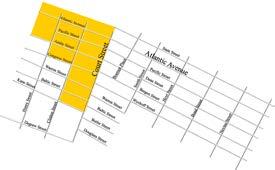SPRING 2016
Architectural Styles Early Development With connectivity to industry, ports, and Manhattan to the west, original development in Cobble Hill and Boerum Hill began in the 1830s. Cobble Hill developed prior to Boerum Hill due in part to its proximity to the South Ferry, which opened in 1836. Large family farms were subdivided beginning in the 1830s and sold to speculative builders. Early development of the area was meant to attract affluent residents who had the ability to commute to Manhattan from South Brooklyn via newly established transportation. The oldest house now standing in the study area is located at 122 Pacific Street, built in or shortly before 1833 on the 13-block farm that once belonged to Ralph Patchen. The house’s Greek Revival door remains intact, but other features have been altered through the years.1 As row house construction continued, religious, institutional, and commercial development began to support the growing community. Cornelius Heeney, a wealthy bachelor and Roman Catholic with the land plot next to Patchen in Cobble Hill, gifted his land to St. Paul’s Catholic Church. Built in 1838, it is the oldest Catholic Church in contiguous use in New York State.2
1 Landmarks Preservation Commission. Cobble Hill Historic District Designation Report. New York City: Landmarks Preservation Commission, 1969. 2 Sleeper, James. "St. Paul's Holds Rededication Mass After Parishioners Rally To Save Church's 140 Year Heritage." The Phoenix, December 15, 1977.
40 Architectural Development
122 Pacific Street
St. Paul's Catholic Church
Source: student photograph
Source: student photograph




















